Our understanding of everything in the 21st Century is constantly changing. In an era of science, where we have made leaps and bounds in all fields of STEM. It is awe-inspiring to see how far we have taken laws from Maxwell, Faraday or Tesla into creating systems that would not even have been part of their imagination.
As transistors have gotten smaller and faster at switching. The conventional understanding of electronics was once again stretched and brought to scrutiny towards the end of the 19th century. Decades back when the transistors had begun to cross the threshold into the high-speed design. Engineers were quick to notice that their systems are constantly failing. A season of panic set in at the dawn of personal computers, when electronics devices had to be cheap, fast, thermally & specially efficient and compliant to strict norms. The semiconductor industry was in the chase for people with the right understanding of electronics design and how they work! And out of these traumas came some of the pioneers in the field of electronics hardware design and EMC such as Rick Hartly, Dan Beeker, and Eric Bogatin.
And they understood one thing, Conventional wisdom in electronics design is wrong (or cannot explain what was happening) and cannot be used in High-speed hardware Design.
Getting Started:
In Hardware Design, Mixed-signal Design involves the integration of a system that has an analog and a digital part together. ADCs are usually the centerpiece of such a system. This is frankly due to the fact that an ADC is what links the analog section to the digital domain. Most high speed and/or precision ADC available in the market are dedicated chips that interface over a communication protocol depending on the amount of data the needs to transfer to the processor and laying such a system down involves making sure that the signal integrity of (mainly) the analog section is as good as possible.
The High-speed Mixed Signal design draws a lot of close parallels with Digital High-Speed design. Digital High-speed designers deal with switches which have voltage rise times in the order of picoseconds, and all this activity contribute to a new field of science called EMC/EMI. Drawing from the research that J. C Maxwell, the German physicist Heinrich Hertz was the first to demonstrate the propagation of energy in air. But it wasn’t until the dawn of computers that EMI/EMC had drawn such an amount of attention as that of now. When the computers started to become cheaper and a common household device, the boom in EMI emitting system become more than just a general concern. It was crucial that the system works without being susceptible or becoming the aggressor in any space. The 1980’s where the time when electronics started moving closer to being a more precise science.
.png)
When designing a mixed signal board, you are always motivated to create the best hardware for the job. This means you would want to attain the best noise floor and get the least amount of noise in your data.
If you have a comprehensive system with many (more than 3) analog chips, it is crucial to compute a noise budget. The noise budget is the maximum amount of noise that you are willing to tolerate. It is also the maximum number of bits on the ADC that you are willing to throw out of the window when you are computing you analog data. And this is serious stuff, when you have noisy bits floating around in your calculation, it’s easier to throw them out than to take it into your math and then to let the MCU decide the best approximation in computation time.
A good measure noise budget can be obtained from the LSB (Least Significant Bit → into Voltage) of your ADC. If your noise is < 75% of your LSB, then your design is good to go. Do understand that we are talking about dynamic characteristics of your analog system. You also have to account of all nonlinearity that are static characteristics of your system (differential, integral nonlinearity, offsets, and gain drifts, etc.) separately.
The noise becomes more profound in high precision ADCs with above 16Bits of precision. These ADC use a special kind of newly developed architecture known as a delta-sigma ADC. The delta-sigma modulator converters your analog voltage into a 1-bit modulated using an over sampler and then followed by some more computation to give you the precision you are looking for in the order of nV (20bits and above). But here’s where the marketing proves to be a lie, these ADCs produce high amounts of internal noise that can easily sweep 3-6 bits of your system precision. Some provide internal Integrated PGA (Programmable gain amplifier) that can internally ramp up the system voltage in hopes that it will give you a better precision. Another workaround that is used is an ultra-precise internal reference with thermal drift (as low as 5ppm). To combat power supply noise, some system employs ratio metric sensing that can further eliminate noises from coupling into the system through the power supply lines. Most of these customizations are already available in low-speed high precision ADCs.

High-Speed Hardware Layout Design:
A good layout with sufficient SI and PI can be achieved by keeping these few things in mind. Following these will make you one of the best Layout Engineers in the world (Well almost):
- Minimize cross talk between traces.
- Provide a definite and low impedance return path.
- Maintain track impedance and timing skew where necessary.
- Placement of Components.
Stay tuned for the second part, where we will talk more about Cross talk and Return paths.
About the Author:
Tony is currently the Lead Hardware Design Engineer at Nymble Labs, Bangalore, India. He is a conventional electronics geek and love to indulge in anything and everything related to chips (fried and baked alike!). His experience mainly revolves around Mixed-signal design and Power electronics with a dab of High-Speed Design and EMC/EMI. In the meanwhile, he reads books and listens to podcasts that center around history and human psychology as a diversion. He often loves to geek out, and making a conversation with him is so much easier when it’s on any one of these topics.
%20(1).png)


